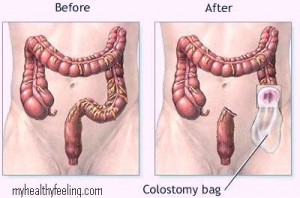Colostomy reversal is the kind of surgery wherein the rectum and colon (large intestine) are reconnected after colostomy was performed previously. This surgical procedure is quite common and is found helpful by patients.
Before colostomy reversal
Colostomy is a surgical process of the colon in which it is split in half. The end of it that leads to the stomach is brought via the abdominal wall in which it is then attached to a bag placed for the draining of bowel movements. The other end that goes to the rectum is sealed off which then turns dormant. Another name for this surgical procedure is called Hartmann’s Colostomy. The colostomy surgery is done when a patient has either blockage, infection or a severe trauma in relation to the colon. This kind of surgery is considered a major operation so one should not take this operation lightly. This also needs a close and serious discussion between the doctor and the patient. This surgical process usually lasts four hours or more. This entirely depends on the kind of infection the patient has and the difficulty of the process.
After colostomy
The other type of colostomy surgery which patients have is the colostomy reversal, also known as laparoscopic colostomy reversal. This surgical procedure involves the reattachment of the rectum and large intestine after the colostomy procedure.
Purpose of colostomy reversal
Its purpose is to restore the functionality and the appearance of the intestine, rectum and abdomen of the patient. It gives the patient the opportunity to live without having bags attached to their stomach. Most patients who have undergone the reversal procedure were able to have normal bowel movements directly through the anus.
Colostomy Surgery
Before the surgery, the patient must first take a certain medicine that will flush out everything inside the stomach, cleaning it through bowel movement. It is necessary for the intestines to be empty prior to the surgery. All patients going through operation, whether minor or major surgery, are required to change into hospital gowns. An IV is then placed inside the vein of the arm. An anesthesiologist will be the one to administer the general anesthesia in order for the patient to be asleep during surgery.
The surgeon will then be making two to five small incisions where the laparoscope and surgical tools will pass through. By filling it with carbon dioxide, the abdominal wall can then be raised from the internal organs. With the use of a stapling device, the colon and rectum are then reattached. The surgical process is ended by stitching the incisions back and wrapped with bandages.
Complications
There is a possibility of having complications after the colostomy reversal surgery. Most of them are allergic reactions to medications and anesthesia given for the surgery. While some patients experience difficulty in drinking and eating, less than normal urination or no urination at all, blood accompanying bowel movement, sore or hard abdomen, having more bowel movements or no bowel movement at all for at least two days after surgery.
Generally, though, the results of colostomy reversal surgery are good. Many patients find that they recover well and have no problems in drinking, eating and having normal bowel movements.

I抦 impressed, I have to say. Actually not often do I encounter a weblog that抯 each educative and entertaining, and let me tell you, you could have hit the nail on the head. Your thought is excellent; the difficulty is something that not enough people are speaking intelligently about. I am very blissful that I stumbled throughout this in my seek for something regarding this.